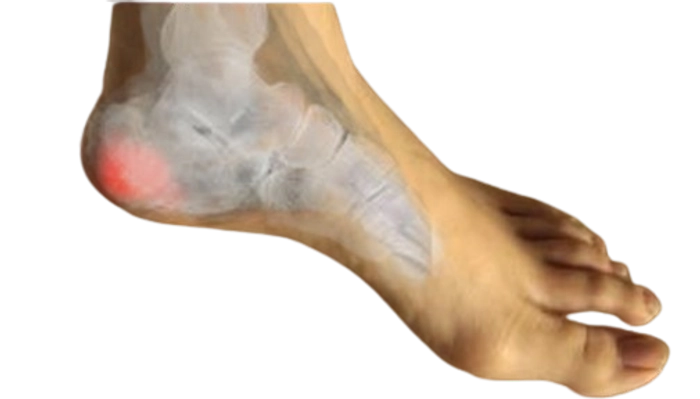Introduction
Calcaneal Spurs, also known as heel spurs, are bony outgrowths that develop on the underside of the heel bone. While not always painful, they can cause discomfort and interfere with daily activities, particularly when walking or standing for long periods. At Dhyan Healthcare, we are committed to helping you understand and manage calcaneal spurs effectively.
What Causes Calcaneal Spurs?
Calcaneal spurs develop in response to prolonged stress on the heel bone and surrounding tissues. Contributing factors include:
- Repetitive Stress: From activities like running, jumping, or standing for long periods.
- Foot Mechanics: Flat feet, high arches, or abnormal walking patterns.
- Obesity: Excess weight increases pressure on the heels.
- Tight Achilles Tendon: Causes tension and pulls on the heel bone.
- Footwear: Ill-fitting shoes or high heels that do not provide proper support.
Symptoms of Calcaneal Spurs
- Heel Pain: Especially when walking or standing, often worse in the morning or after periods of rest.
- Tenderness: On the underside of the heel where the spur is located.
- Swelling and Inflammation: Around the affected area.
- Difficulty Walking: Due to pain and stiffness in the heel.
Diagnosis
Accurate diagnosis involves a thorough examination by a healthcare professional, which may include:
- Medical History: Discussing symptoms and activities that may contribute to heel pain.
- Physical Examination: Palpating the heel for tenderness and assessing foot mechanics.
- Imaging Tests: X-rays to confirm the presence and size of the spur.
Treatment Options
Managing calcaneal spurs focuses on relieving symptoms, reducing inflammation, and addressing underlying causes. Here’s a comprehensive treatment plan:
-
Non-Surgical Treatments
- Footwear Modifications
- Prescription: Wear shoes with cushioned soles and adequate arch support.
- Benefits: Reduces pressure on the heel and alleviates pain.
- Orthotic Devices
- Prescription: Custom-made orthotic inserts or heel pads.
- Benefits: Provides support and redistributes pressure away from the spur.
- PRODUCTS AVAILALBLE ON DHYAN HEALTHCARE WEBSITE:
- TYNOR Heel Cup Silicone - Comfort & Support for Your Feet (dhyanhealthcare.in)
- Experience Comfort with Heel Soft - MEDI (dhyanhealthcare.in)
- TYNOR Heel Cushion Silicon - Comfort & Pain Relief (dhyanhealthcare.in)
- VISSCO Silicon Heel Pad - Comfort & Pain Relief (dhyanhealthcare.in)
- VISSCO Silicon Heel Cushion Pad - Comfort & Support (dhyanhealthcare.in)
- LP Heel Care Cushion Cup - Ultimate Comfort & Support (dhyanhealthcare.in)
- Silicon heel cushion with soft gel - NUORTHO - Dhyan Healthcare
- Physical Therapy
- Prescription: Stretching and strengthening exercises for the foot and calf muscles.
- Examples:
- Calf Stretch: Using a towel or strap to stretch the calf muscles.
- Plantar Fascia Stretch: Pulling the toes towards the body to stretch the plantar fascia.
- Benefits: Improves flexibility, reduces tension on the heel, and promotes healing.
- Physical Therapy
- Footwear Modifications
-
Medications
- Prescription: Over-the-counter pain relievers like ibuprofen or acetaminophen.
- Benefits: Alleviates pain and reduces inflammation.
-
Icing
- Prescription: Apply ice packs to the heel for 15-20 minutes several times a day.
- Benefits: Reduces swelling and numbs pain.
-
Cortisone Injections
- Prescription: Injections of corticosteroids into the heel.
- Benefits: Provides temporary relief from pain and inflammation.
-
Extracorporeal Shock Wave Therapy (ESWT)
- Prescription: High-energy shock waves directed at the heel.
- Benefits: Stimulates healing and reduces pain.
-
Night Splints
- Prescription: Splints worn at night to stretch the plantar fascia and Achilles tendon.
- Benefits: Prevents tightening of the tissues overnight.
-
Surgical Intervention
- Prescription: Surgery may be considered if conservative treatments fail to provide relief.
- Examples:
- Spur Removal: Surgical removal of the spur.
- Release of Plantar Fascia: To relieve tension and reduce pain.
- Benefits: Provides long-term relief from symptoms.
Lifestyle and Home Remedies
In addition to professional treatment, several home remedies and lifestyle adjustments can help manage calcaneal spurs:
- Rest: Avoid activities that aggravate heel pain.
- Gentle Stretching: Perform regular stretching exercises for the calf and foot muscles.
- Maintain a Healthy Weight: Reduces pressure on the heels.
- Proper Footwear: Wear supportive shoes with cushioned soles and arch support.
- Avoid High-Impact Activities: Minimize activities that put excessive strain on the heels.
When to See a Doctor
If you experience persistent heel pain or notice a bony protrusion on the underside of your heel, it’s crucial to seek medical attention. Early diagnosis and treatment can prevent complications and improve your quality of life.
Conclusion
Managing calcaneal spurs effectively requires a combination of professional medical treatment, supportive therapies, and proactive self-care. At Dhyan Healthcare, we are dedicated to providing comprehensive care tailored to your individual needs. If you suspect you have a calcaneal spur, don’t hesitate to contact us for a detailed evaluation and personalized treatment plan.
For more information or to schedule an appointment, visit our website or call our clinic. Your journey to pain-free heels and improved mobility starts here!


